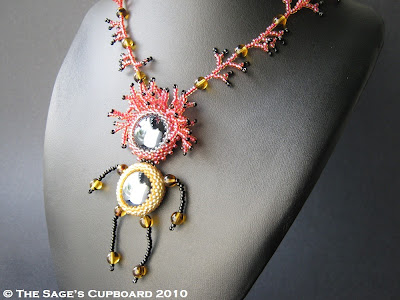We are still using some of our ancestors’ favorite materials today, like leather, stones, shells and even porcupine quills. But the world of found object beading has grown into a beautiful art form that can incorporate everything from trash and scraps to everyday household objects.
Most found object jewelry uses assemblage methods like stringing, wire work, cold connections and mixed media techniques. So when I started flipping through the pages of Beaded Jewelry with Found Objects at my library, I was thrilled to discover that most of the book’s projects use beadweaving techniques.
You might be familiar with the work of author Carole Rodgers, who also gave us titles like Beading Basics
The first few chapters provide in-depth descriptions of the beads, findings, thread and materials used in the book, along with design tips and basic beading information for the absolute beginner. Each of the bead weaving techniques used is covered in excellent detail, with easy to understand illustrations of the stitches. All of the essential weaves are included, like right angle weave and peyote, along with a few less common techniques like Chevron chain and Potawatomi weave.
An entire chapter is dedicated completely to beading with cabochons and irregular shaped stones, with ten gorgeous necklace and brooch projects to try out. Six more project chapters cover found objects like hardware, fishing tackle, and buttons. The game pieces chapter includes a Scrabble tile project that is so unlike the pendants that we’re used to, that it makes tiles-as-beads seem like a whole new idea again.
What I love about this book is that although the focus is on bead weaving, the projects are not so elaborate and complicated that only a beading expert could try them. Beaded Jewelry with Found Objects
Each chapter finishes with an inspiration gallery, and includes some beautiful project variations, and designs using the suggested found objects. My favorites are some fantastic beaded dolls by Sigrid Wynn Evans and Cheryl Erickson.
Today’s necklace-a-day design was inspired by these beaded dolls. I used some of my favorite ‘found’ objects - glass nuggets or globs. My current color choices are black, blue or green, and since I didn’t want to do anything too woodsy or aquatic to start, I went with some black nuggets, then added topaz and amber colored beads for a leopard print effect.
For the fringe hair, I wanted to do something wild, so I found some mauve lined topaz seed beads that have a delicious red color, but still blend in with the other bead shades. I like the overall look of the doll - even the little druk hands and feet have a charming quality to them. I think I will have to make a few more with different themes!
Copyright 2010 Inspirational Beading and Carole Rodgers






Adorable!!! Love the wild hair!
ReplyDeleteI love the beading with seed beads. I can't imagine how much patience you would need to do some of the more exquisite ones.
ReplyDeleteI think the amount of patience you need depends on how much you enjoy the technique you're using, and how excited you are about the end result.
ReplyDeleteAdding bezels to glass nuggets does require a little patience, though. You pretty much have to wait until all the rows are in place before you know if it'll take hold. But that's part of the challenge of using found objects!